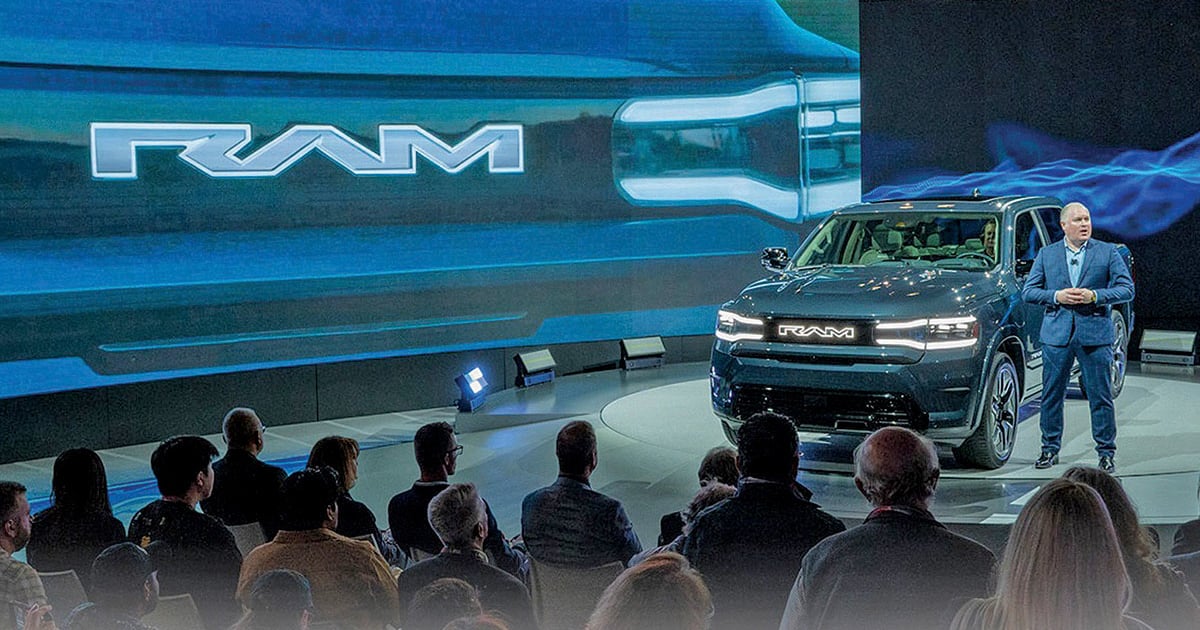
NEW YORK — The electric pickup with a 500-mile range that Ram showed here last week represents the future for Stellantis.
But getting there by late 2024, when the Ram 1500 REV is slated to reach dealerships, is a costly proposition. That’s why company executives at the New York International Auto Show emphasized the need to boost profitability, cut costs and confront sliding sales of today’s gasoline-powered lineup to fund the shift to electric vehicles.
The REV is “what we’re here to celebrate and talk about, but it’s expensive,” Ram CEO Mike Koval Jr. told Automotive News. “That’s the elephant in the room for everybody. The cost of electrification is expensive, so for sure we need to make sure that we protect the profitability of our current in-market [internal combustion engine] business to help fund the transition to electrification.”
Protecting those profits amid the pandemic, inflation, regulatory changes, the microchip shortage and other developments has been a challenge. The costs related to developing and building EVs are among the reasons Stellantis cited in idling its Jeep Cherokee plant in Illinois at the end of February.
“The question is, how do we tackle those additional costs,” Stellantis CEO Carlos Tavares said at a media roundtable last week. “If we don’t do it, we are just going to have a significant reduction of the size of the market because [the] middle class will not be able to buy EVs, very simply put. So it is not in the interest of the corporations. It’s not in the interest of the citizens. It’s not in the interest of the unions that we shrink the market because we become too pricey for the middle classes.”
Stellantis plans to launch more than 25 EVs in the U.S. by 2030. Ram plans to roll out an electric version of its ProMaster van, which will be deployed by Amazon, this year, followed by the 1500 REV in 2024.
Ram’s EV plans also appear to include a midsize pickup. The brand showed dealers a concept truck in March, and Koval said the next step is to decide which platform to use and where to sell it. Although the concept is a full EV, Koval said the truck could have a gasoline variant, too, because not every country is shifting to EVs at the same rate.
“There’s been enough talk; now it’s time to execute,” Koval said. “We’ve got feedback from the dealers [that] we’re on the right track. They liked what they saw. Now I’ve got to do it. So there’s some corporate bureaucratic approval process, but we’re on the right track.”
Stellantis is also still deciding where to build the REV. North America COO Mark Stewart said last week it will be in the U.S. Illinois officials are pushing for that to happen at the idled Jeep plant.
First-quarter U.S. sales results partially reflect the company’s efforts to preserve margins so it can fund the EV shift. Stellantis posted a 9.1 percent decline, including a 6.8 percent slide for Ram and a 20 percent drop for Jeep.
Ram’s sales dip was expected, Koval said, because the brand “slowed things down” by pulling back on incentives and marketing late last year to preserve margins. Ram had an 81-day supply of vehicles at the end of March, he said, which is reminiscent of dealership inventory before the pandemic. Koval said there’s an emphasis on reducing costs and inefficiencies that he hasn’t seen in his two decades at the company and its predecessors. The macroeconomic backdrop, he said, is “still kind of gloomy out there,” with higher interest rates among the biggest headwinds.
“Affordability is becoming an issue, so we’re feeling some pressure on the pricing,” Koval said. “But so far, we’ve resisted the temptation to resort to bad habits.
“Fortunately for me, my demand is so high around the world outside of North America, I can move my cars. If things slow down in the U.S., Canada was up, Mexico’s up, fleet was up. It was just U.S. retail is a little rocky.”
Jeep’s average discount in the first quarter of $2,137 is roughly $450 higher than a year earlier, according to Motor Intelligence data, though still about $1,000 less than the same period in 2021.
Jeep CEO Christian Meunier said the brand expects a stronger second quarter because it’s ramping up production of the Grand Cherokee, Wagoneer and Grand Wagoneer. Jeep is working to protect the residual value of its products by keeping incentives in check, he said.
“I want to keep it where we are. I think we’re in a good spot now,” Meunier said. “We want to keep our pricing power intact, and we just need to produce the right car at the right place. I think we had a few challenges of allocating the cars because [we] were in a shortage at one point.”